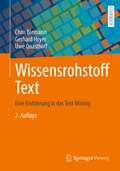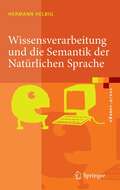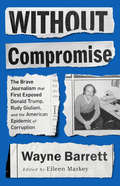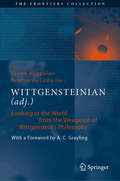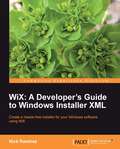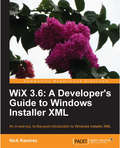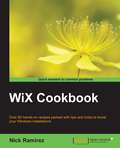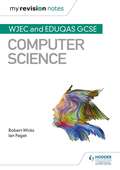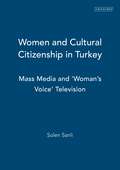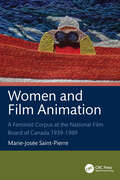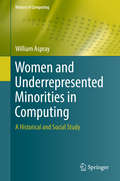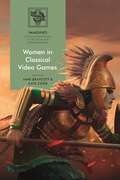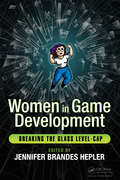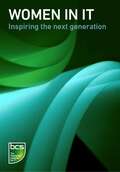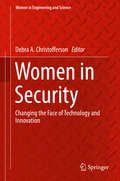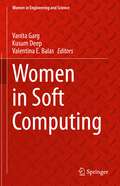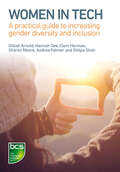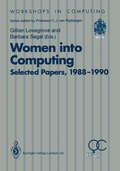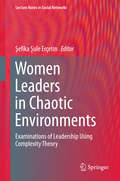- Table View
- List View
Wissensrohstoff Text: Eine Einführung in das Text Mining
by Chris Biemann Gerhard Heyer Uwe QuasthoffDer größte Teil des Weltwissens ist in digital verfügbaren Texten beschrieben. Diese Texte stellen einen bedeutsamen Wissensrohstoff dar, doch wie kann dieses Wissen extrahiert werden? Lernen Sie in dieser aktualisierten und erweiterten Neuauflage des ersten deutschen Lehrbuches zu diesem Thema, wie digitaler Text mit Hilfe von Text Mining aufbereitet, verarbeitet und in Anwendungen genutzt werden kann.
Wissensverarbeitung und die Semantik der Natürlichen Sprache: Wissensrepräsentation mit MultiNet (eXamen.press)
by Hermann HelbigDas Buch ist zwischen Künstlicher Intelligenz, Linguistik und Kognitionswissenschaften angesiedelt. Es stellt Methoden zur Bedeutungsrepräsentation natürlichsprachlicher Information auf der Basis „Mehrschichtiger Erweiterter Semantischer Netze" (MultiNet) umfassend dar. Die Methodik eignet sich sowohl für theoretische Untersuchungen wie für die automatische Sprachverarbeitung. Für die 2. Auflage hat der Autor den aktuellen Stand der Forschung eingearbeitet, der MultiNet-Formalismus selbst und damit seine Beschreibung bleiben jedoch unverändert.
Without Compromise: The Brave Journalism that First Exposed Donald Trump, Rudy Giuliani, and the American Epidemic of Corruption
by Wayne BarrettA collection of groundbreaking investigations by Wayne Barrett, the intrepid, muckraking Village Voice journalist who exposed corruption in New York City and beyond.With piercing moral clarity and exacting rigor, Wayne Barrett tracked political corruption in the pages of the Village Voice fact by fact, document by document for 40 years. The first to report on the scams and crooked deals that fueled the rise of Donald Trump in 1979, Barrett went on to expose the shady dealings of small-time slum lords and powerful New York City politicians alike, from Ed Koch to Rudy Giuliani to Michael Bloomberg.Without Compromise is the first anthology of Barrett's investigative work, accompanied by essays from colleagues and those he trained. In an age of lies, fog, and propaganda, when the profession of journalism is degraded by the White House and the industry is under financial threat, Barrett reminds us that facts, when clearly accumulated, are our best defense of democracy.Featuring essays by:Joe ConasonKim Phillips-FeinErrol LouisGerson BorreroTom RobbinsTracie McMillanPeter NoelAdam FifieldJarrett MurphyAndrea BernsteinJennifer GonnermanMac Barrett
Wittgenstein, Language and Information: "Back to the Rough Ground!" (Information Science and Knowledge Management #10)
by David Blair“The more narrowly we examine language, the sharper becomes the con?ict - tween it and our requirement. (For the crystalline purity of logic was, of course, not a result of investigation; it was a requirement. ) The con?ict becomes intolerable; the requirement is now in danger of becoming empty. —We have got onto slippery ice where there is no friction and so in a certain sense the conditions are ideal, but also, just because of that, we are unable to walk. We want to walk; so we need 1 friction. Back to the rough ground!” —Ludwig Wittgenstein This manuscript consists of four related parts: a brief overview of Wittgenstein’s p- losophy of language and its relevance to information systems; a detailed explanation of Wittgenstein’s late philosophy of language and mind; an extended discussion of the re- vance of his philosophy to understanding some of the problems inherent in information systems, especially those systems which rely on retrieval based on some representation of the intellectual content of that information. And, fourthly, a series of detailed footnotes which cite the sources of the numerous quotations and provide some discussion of the related issues that the text inspires. The ?rst three of these parts can each be read by itself with some pro?t, although they are related and do form a conceptual whole.
WITTGENSTEINIAN: Looking at the World from the Viewpoint of Wittgenstein's Philosophy (The Frontiers Collection)
by Shyam Wuppuluri Newton Da Costa“Tell me," Wittgenstein once asked a friend, "why do people always say, it was natural for man to assume that the sun went round the earth rather than that the earth was rotating?" His friend replied, "Well, obviously because it just looks as though the Sun is going round the Earth." Wittgenstein replied, "Well, what would it have looked like if it had looked as though the Earth was rotating?” What would it have looked like if we looked at all sciences from the viewpoint of Wittgenstein’s philosophy? Wittgenstein is undoubtedly one of the most influential philosophers of the twentieth century. His complex body of work has been analysed by numerous scholars, from mathematicians and physicists, to philosophers, linguists, and beyond. This volume brings together some of his central perspectives as applied to the modern sciences and studies the influence they may have on the thought processes underlying science and on the world view it engenders. The contributions stem from leading scholars in philosophy, mathematics, physics, economics, psychology and human sciences; all of them have written in an accessible style that demands little specialist knowledge, whilst clearly portraying and discussing the deep issues at hand.
WiX: A Developer's Guide To Windows Installer Xml
by Nick RamirezA practical guide, this book provides step-by-step instructions for building your installer, showcasing real-world examples throughout. Its purpose is to get the professional developer building installers in no time without getting bogged down in theory. Numerous references to additional resources are provided so that curious readers can supplement the knowledge they gain here with additional details. If you are a developer and want to create installers for software targeting the Windows platform, then this book is for you. You'll be using a lot of XML so that you get accustomed to the basics of writing well-formed documents, using XML namespaces and the dos and don'ts of structuring elements and attributes. You should know your way around Visual Studio, at least enough to compile projects, add project references, and tweak project properties. No prior knowledge of Windows Installer or WiX is assumed.
WiX 3.6: A Developer's Guide to Windows Installer XML
by Nick RamirezA step-by-step tutorial with plenty of code and examples to improve your learning curve. If you are a developer and want to create installers for software targeting the Windows platform, then this book is for you. You'll be using plenty of XML and ought to know the basics of writing a well-formed document. No prior experience in WiX or Windows Installer is assumed. You should know your way around Visual Studio to compile projects, add project references and tweak project properties.
WiX Cookbook
by Nick RamirezIf you are a developer with a good understanding of WiX projects and would like to further explore advanced WiX topics, this book is for you. To get the most out of this book, knowledge of proper XML syntax is recommended.
WJEC and Eduqas GCSE Computer Science - My Revision Notes (PDF)
by Rhys Richardson Robert WicksExam board: WJEC Level: GCSE Subject: Computer Science First teaching: September 2017 First exams: Summer 2019 Strengthen your students' understanding and upgrade their confidence with My Revision Notes: WJEC Eduqas GCSE (9-1) Computer Science. Written by leading Computer Science experts this is the only revision guide aimed specifically at helping students prepare for the WJEC or Eduqas exam - a new title in the top-selling revision guide series, loved by students and recommended by teachers. · Let students take control of their revision - plan and focus on the areas where they need to improve their knowledge and understanding with advice and summaries from the experts. · Help them achieve their potential - exam tips on computer science terms and concepts highlighted throughout the book · Improve their exam skills - a range of exam practice questions and 'test yourself questions' with answers at the back of the book.
Women and Cultural Citizenship in Turkey: Mass Media and ‘Woman’s Voice’ Television (Library Of Modern Turkey Ser.)
by Solen SanliTV Talk shows, often seen as vulgar and low-brow, can actually be a vehicle through which hitherto undiscussed topics (such as violence against women or political exclusion) are brought into the public sphere. Solen Sanli argues that this is the case in Turkey, where talk shows often invite ordinary women from lower socio-economic classes to speak of their experiences of family life: marriage, divorce, child custody rights and relations with in-laws. Specifically looking at popular women's talk shows such as these (commonly called 'Woman's Voice' television), Sanli explores how groups with political and cultural power control public discourse and the public sphere in Turkey, and how urban/rural and Islamist/secular oppositions are constructed and evolve. Women and Cultural Citizenship in Turkey traces the development of mass media in Turkey, particularly television, and closely examines how narrations of violence against women are presented. By analysing the discourse that is produced on 'Woman's Voice' programmes, the production patterns of the shows, and their impact on the home audience, Sanli argues that these programmes enable women to construct first-hand narrations of the violence which is exerted against them. This is a significant development from the previous situation, where women's experiences were represented by the 'republican elite' of Turkey through state-sponsored Turkish Radio and Television (TRT). Drawing on Pierre Bourdieu's conceptualisations of capital and power, this book coins the term 'republican capital' to distinguish those portions of Turkish society which have largely monopolised mass media and the public sphere from the women who are now finding a voice through WV television. Women and Cultural Citizenship in Turkey offers topical and original insights relevant for a range of disciplines, such as Anthropology, Gender and Communication Studies, as well as those researching cultural and political participation in the Middle Eas
Women and Film Animation: A Feminist Corpus at the National Film Board of Canada 1939-1989
by Marie-Josée Saint-PierreThe creations of female animation filmmakers are recognized all over the world while being, paradoxically, unknown to the general public. Women and Film Animation: A Feminist Corpus at the National Film Board of Canada 1939-1989 brings out of the shadows the work of true pioneers by presenting and analyzing, from a resolutely feminist perspective, the works they have conceived within the National Film Board of Canada (NFB).This institution has played an essential role in the emergence of animated cinema in Canada, but it is forgotten or ignored that a good part of this vast corpus is the work of women who have worked there not only as assistants but also as directors. These artists have contributed to changing the traditional representations of women in a unique way in both commercial and avant-garde animated cinema. The author accounts for their concerns, their creativity, and their many bright achievements. To do this, she relies on a wide range of critical works in social and cultural history of Canada, in feminist art history, and on multiple studies on animated cinema.Key Features: Provides an interdisciplinary approach that combines concepts from feminist studies, film theory and visual arts for a nuanced analysis of the role of women in animated cinema Discusses historical and sociological background that sheds light on the condition of women Includes a profound analysis of the changes and continuities in the role of women in this industry over time, focusing on the National Film Board of Canada Features previously unreleased archival material and selected excerpts from reviews by the NFB’s programming committee, highlighting the impact of production circumstances of the works of specific women animators
Women and Film Animation: A Feminist Corpus at the National Film Board of Canada 1939-1989
by Marie-Josée Saint-PierreThe creations of female animation filmmakers are recognized all over the world while being, paradoxically, unknown to the general public. Women and Film Animation: A Feminist Corpus at the National Film Board of Canada 1939-1989 brings out of the shadows the work of true pioneers by presenting and analyzing, from a resolutely feminist perspective, the works they have conceived within the National Film Board of Canada (NFB).This institution has played an essential role in the emergence of animated cinema in Canada, but it is forgotten or ignored that a good part of this vast corpus is the work of women who have worked there not only as assistants but also as directors. These artists have contributed to changing the traditional representations of women in a unique way in both commercial and avant-garde animated cinema. The author accounts for their concerns, their creativity, and their many bright achievements. To do this, she relies on a wide range of critical works in social and cultural history of Canada, in feminist art history, and on multiple studies on animated cinema.Key Features: Provides an interdisciplinary approach that combines concepts from feminist studies, film theory and visual arts for a nuanced analysis of the role of women in animated cinema Discusses historical and sociological background that sheds light on the condition of women Includes a profound analysis of the changes and continuities in the role of women in this industry over time, focusing on the National Film Board of Canada Features previously unreleased archival material and selected excerpts from reviews by the NFB’s programming committee, highlighting the impact of production circumstances of the works of specific women animators
Women and Underrepresented Minorities in Computing: A Historical and Social Study (History of Computing #0)
by William AsprayThis text examines in detail the issue of the underrepresentation of women, African Americans, American Indians, and Hispanics in the computing disciplines in the U.S. The work reviews the underlying causes, as well as the efforts of various nonprofit organizations to correct the situation, in order to both improve social equity and address the shortage of skilled workers in this area. Topics and features: presents a digest and historical overview of the relevant literature from a range of disciplines, including leading historical and social science sources; discusses the social and political factors that have affected the demographics of the workforce from the end of WWII to the present day; provides historical case studies on organizations that have sought to broaden participation in computing and the STEM disciplines; reviews the different approaches that have been applied to address underrepresentation, at the individual, system-wide, and pathway-focused level; profiles the colleges and universities that have been successful in opening up computer science or engineering to female students; describes the impact of individual change-agents as well as whole organizations.
Women in Classical Video Games (IMAGINES – Classical Receptions in the Visual and Performing Arts)
by Edited by Jane Draycott and Kate CookDespite the prevalence of video games set in or inspired by classical antiquity, the medium has to date remained markedly understudied in the disciplines of classics and ancient history, with the role of women in these video games especially neglected. Women in Classical Video Games seeks to address this imbalance as the first book-length work of scholarship to examine the depiction of women in video games set in classical antiquity. The volume surveys the history of women in these games and the range of figures presented from the 1980s to the modern day, alongside discussion of issues such as historical accuracy, authenticity, gender, sexuality, monstrosity, hegemony, race and ethnicity, and the use of tropes. A wide range of games of different types and modes are discussed, with particular attention paid to the Assassin's Creed franchise's 21st-century ventures into classical antiquity (first in Origins (2017), set in Hellenistic Egypt, and then in Odyssey (2018), set in classical Greece), which have caught the imagination not only of gamers, but also of academics, especially in relation to their accompanying educational Discovery Modes. The detailed case studies presented here form a compelling case for the indispensability of the medium to both reception studies and gender studies, and offer nuanced answers to such questions as how and why women are portrayed in the ways that they are.
Women in Classical Video Games (IMAGINES – Classical Receptions in the Visual and Performing Arts)
Despite the prevalence of video games set in or inspired by classical antiquity, the medium has to date remained markedly understudied in the disciplines of classics and ancient history, with the role of women in these video games especially neglected. Women in Classical Video Games seeks to address this imbalance as the first book-length work of scholarship to examine the depiction of women in video games set in classical antiquity. The volume surveys the history of women in these games and the range of figures presented from the 1980s to the modern day, alongside discussion of issues such as historical accuracy, authenticity, gender, sexuality, monstrosity, hegemony, race and ethnicity, and the use of tropes. A wide range of games of different types and modes are discussed, with particular attention paid to the Assassin's Creed franchise's 21st-century ventures into classical antiquity (first in Origins (2017), set in Hellenistic Egypt, and then in Odyssey (2018), set in classical Greece), which have caught the imagination not only of gamers, but also of academics, especially in relation to their accompanying educational Discovery Modes. The detailed case studies presented here form a compelling case for the indispensability of the medium to both reception studies and gender studies, and offer nuanced answers to such questions as how and why women are portrayed in the ways that they are.
Women in Game Development: Breaking the Glass Level-Cap
by Jennifer Brandes HeplerVideogame development is usually seen as a male dominated field; even playing videogames is often wrongly viewed as a pastime for men only. But behind the curtain, women have always played myriad important roles in gaming. From programmers to artists, designers to producers, female videogame developers endure not only the pressures of their jobs but also epic levels of harassment and hostility. Jennifer Brandes Hepler’s Women in Game Development: Breaking the Glass Level-Cap gives voice to talented and experienced female game developers from a variety of backgrounds, letting them share the passion that drives them to keep making games. Key Features Experience the unique stories of nearly two dozen female game developers, from old-school veterans to rising stars. Understand the role of women in videogames, from the earliest days of development to the present day. Hear first-hand perspectives from working professionals in fields including coding, design, art, writing, community management, production and journalism. Get tips for how to be a better ally and make your company and teams more inclusive. Learn about the obstacles you face if you’re an aspiring female developer, and how to overcome them. Meet the human face of some of the women who have endured the industry’s worst harassment… and kept on going.
Women in Game Development: Breaking the Glass Level-Cap
by Jennifer Brandes HeplerVideogame development is usually seen as a male dominated field; even playing videogames is often wrongly viewed as a pastime for men only. But behind the curtain, women have always played myriad important roles in gaming. From programmers to artists, designers to producers, female videogame developers endure not only the pressures of their jobs but also epic levels of harassment and hostility. Jennifer Brandes Hepler’s Women in Game Development: Breaking the Glass Level-Cap gives voice to talented and experienced female game developers from a variety of backgrounds, letting them share the passion that drives them to keep making games. Key Features Experience the unique stories of nearly two dozen female game developers, from old-school veterans to rising stars. Understand the role of women in videogames, from the earliest days of development to the present day. Hear first-hand perspectives from working professionals in fields including coding, design, art, writing, community management, production and journalism. Get tips for how to be a better ally and make your company and teams more inclusive. Learn about the obstacles you face if you’re an aspiring female developer, and how to overcome them. Meet the human face of some of the women who have endured the industry’s worst harassment… and kept on going.
Women in IT: Inspiring the next generation
by BCS, The Chartered Institute for ITGender diversity still poses a major challenge in the IT and telecoms industry, with women making up less than 20 per cent of the IT workforce. This ebook seeks to encourage more girls and women to consider a career in IT by showcasing the lives and careers of female IT professionals, entrepreneurs and academics. Its aim is not only to demonstrate the advantages of a career in IT to girls and women, but also to emphasise the proven benefits of gender diversity in the workplace
Women in IT: Inspiring the next generation
by BCS, The Chartered Institute for ITGender diversity still poses a major challenge in the IT and telecoms industry, with women making up less than 20 per cent of the IT workforce. This ebook seeks to encourage more girls and women to consider a career in IT by showcasing the lives and careers of female IT professionals, entrepreneurs and academics. Its aim is not only to demonstrate the advantages of a career in IT to girls and women, but also to emphasise the proven benefits of gender diversity in the workplace
Women in Security: Changing the Face of Technology and Innovation (Women in Engineering and Science)
by Debra A. ChristoffersonThis volume examines core areas of development in security, emphasizing the pivotal contributions of women to the field’s evolution. The author first covers a broad spectrum of key topics, including how security is created, where innovation occurs, what the underpinnings are, and who supports it and how. After an overview of the field, female security professionals share their own stories of technology and innovation in security today; the foundation, where research is headed, and the emerging trends. Women currently make up a very small pocket of cyber security staffing – this book aims to increase the visibility of women in the field and their contributions and encourage other females to join the field. The contributors hold various roles from executive leadership, to engineers, analysts, and researchers.
Women in Soft Computing (Women in Engineering and Science)
by Vanita Garg Kusum Deep Valentina E. BalasThis book gives a detailed information of various soft computing techniques across various fields for solving relevant, real-life problems. The authors, all female leaders in the field, show how soft computing uses approximate calculations to provide imprecise yet usable solutions to complex computational problems. This enables solutions for problems that may be either unsolvable or too time-consuming to solve with current hardware. The authors show how these techniques, when applied, have proven to be efficient and robust in many difficult situations. As an important part of the Women in Science and Engineering book series, the work highlights the contribution of women leaders in soft computing, inspiring women and men, girls and boys to enter and apply themselves to secure the future in the field.
Women in Tech: A practical guide to increasing gender diversity and inclusion
by Sharon Moore Gillian Arnold Hannah Dee Clem Herman Andrea Palmer Shilpa ShahThis guide to tackling the gender imbalance in technology professions offers expertise, initiatives and true stories to support those wishing to bring greater gender diversity into the workplace. It aims to inform regarding background, theory and policy; advise on concrete actions that can be undertaken, and to be an exemplar for companies, organisations, establishments and campaigns in the form of real-world case studies.
Women in Tech: A practical guide to increasing gender diversity and inclusion (G - Reference,information And Interdisciplinary Subjects Ser.)
by Sharon Moore Gillian Arnold Hannah Dee Clem Herman Andrea Palmer Shilpa ShahThis guide to tackling the gender imbalance in technology professions offers expertise, initiatives and true stories to support those wishing to bring greater gender diversity into the workplace. It aims to inform regarding background, theory and policy; advise on concrete actions that can be undertaken, and to be an exemplar for companies, organisations, establishments and campaigns in the form of real-world case studies.
Women into Computing: Selected Papers 1988–1990 (Workshops in Computing)
by Gillian Lovegrove Barbara SegalThis book contains the majority of the papers presented at the 1990 Women into Computing Conference, together with selected papers from the 1989 and 1988 Conferences. In 1988, the main theme running through the Conference was that of dismay at the low number of women taking computing courses or following computing careers. The 1989 Conference was concerned solely with workshops for schoolgirls and the 1990 Conference concentrated on strategies rather than an assessment of the situation. As editors, we set as our task to make a selection of papers presenting the overall picture in 1990. We found that many of the issues discussed in 1988 are still a cause for concern in 1990, but that strategies to improve the situation are many and varied. Section I contains speeches from the invited speakers and needs little introduction. Section II contains papers covering so me attitudes and issues of concern, ranging from the specific (Gill Russell on child care and Laurie Keller on hacker mentality) through to broader aspects of gender inequality (the papers of Flis Henwood, Margaret Bruce and Alison Adam, and Lyn Bryant). Susan Jones takes a look at the reasons why we should want to see more women in computing, whilst Gillian Lovegrove and Wendy Hall present a more general paper on school and higher education.
Women Leaders in Chaotic Environments: Examinations of Leadership Using Complexity Theory (Lecture Notes in Social Networks)
by Şefika Şule ErçetinThis book spotlights how women leaders behave in chaotic environments and features examples of women who have been key figures in determining complex socio-economic outcomes throughout history. Women leaders can be seen on many high- levels in the political arena, be they a prime minister, empress or opinion leader. From Kösem Sultan of the Ottoman Empire to Benazir Bhutto, women leaders have had an undeniable effect on modern history. Is it possible to understand the current role of women in politics in Turkey without the First Lady Emine Erdoğan? Can we analyze Europe’s future without Angela Merkel? There are many different books about women leaders' biography or memoirs of persons who worked closely with them. However, until now, no in-depth scientific analysis of such women leaders with respect to chaos and complexity theory has been available. This work represents a unique and important step towards filling this gap in research, and includes an epilogue presenting women’s leadership model visualized by an eight-pointed star.
